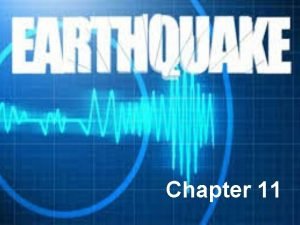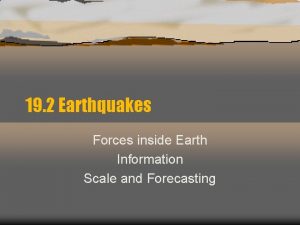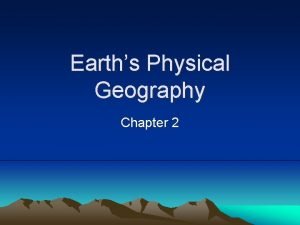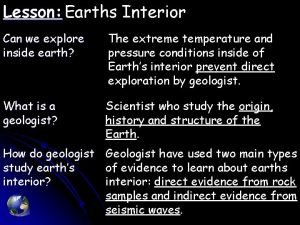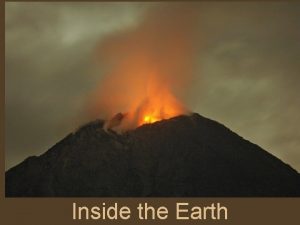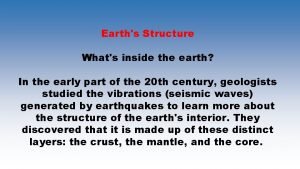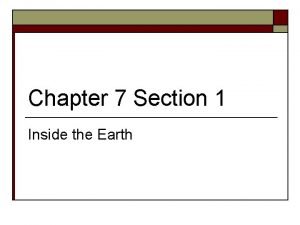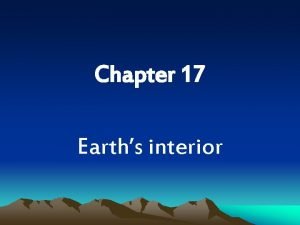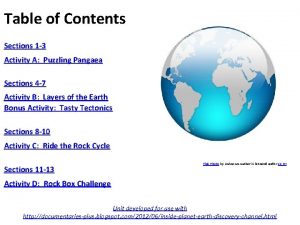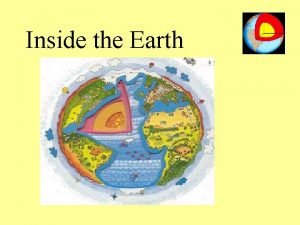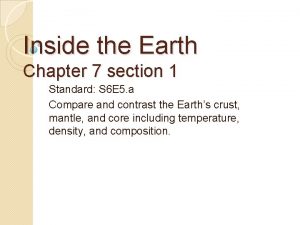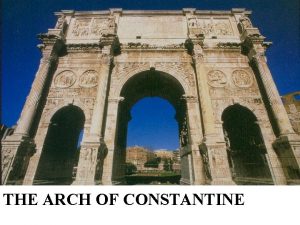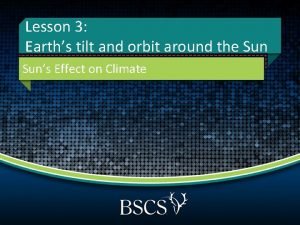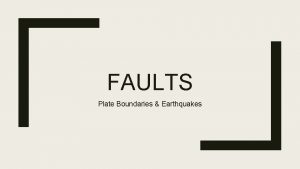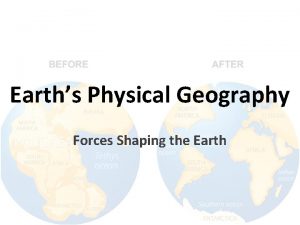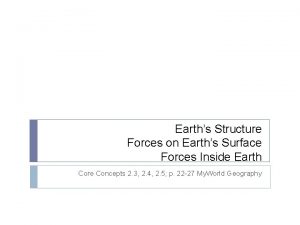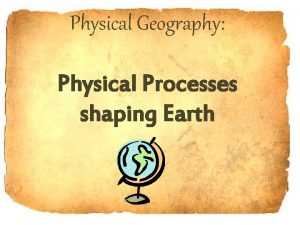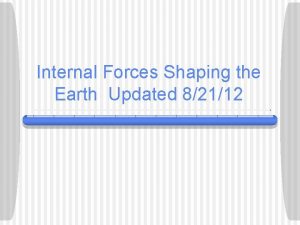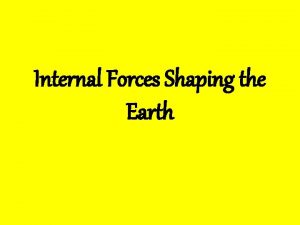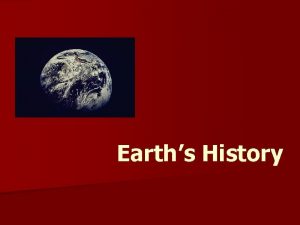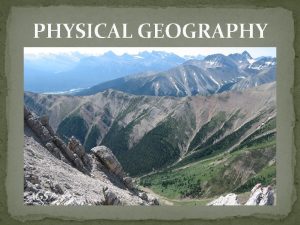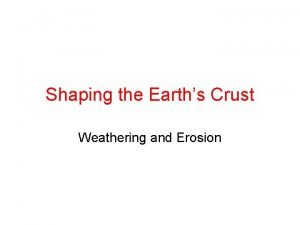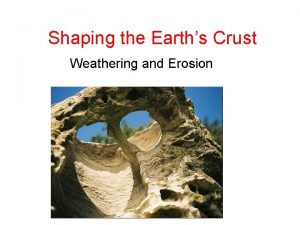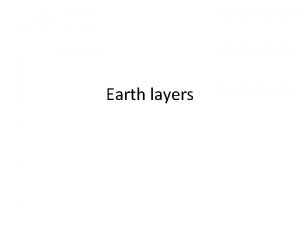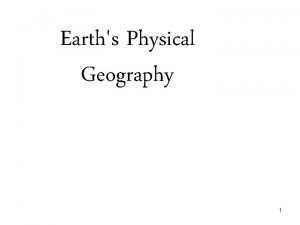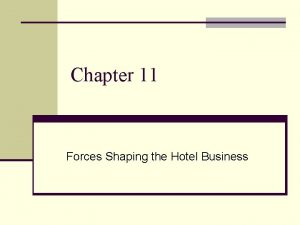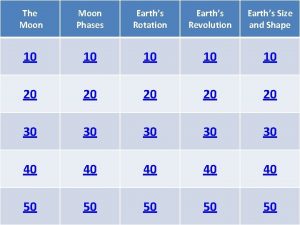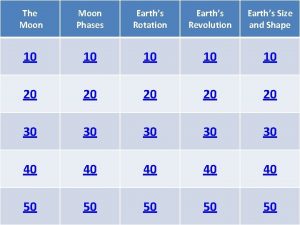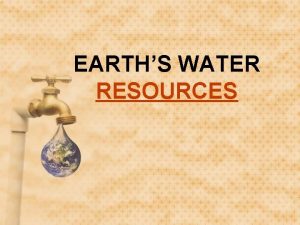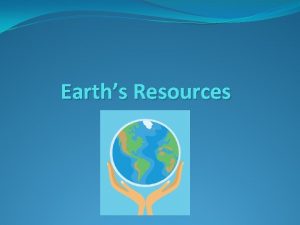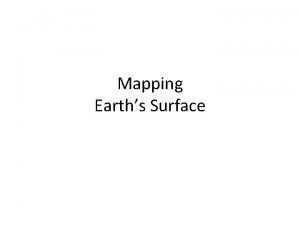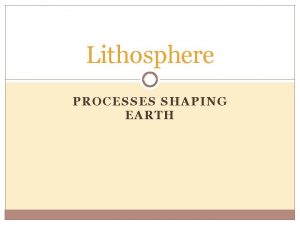Earths Physical Geography Forces Shaping the Earth Inside






































- Slides: 38

Earth’s Physical Geography Forces Shaping the Earth

Inside the Earth • Earth is made up of several layers, each of which has different characteristics – Inner Core – Outer Core – Mantle – Crust – Atmosphere

Inside the Earth • Inner Core – Very hot, dense, solid ball – Roughly 1500 miles in diameter – Roughly 3300 miles below the surface – Mostly made up of iron and nickel – Under immense pressure

Inside the Earth • Outer Core – Metal is in liquid state – Temperature can reach as hot as 8, 500 o. F – Still primarily iron and nickel, but with silicon and oxygen added – Roughly 1630 miles below the surface

Inside the Earth • Mantle – Layer of hot, dense rock • Mostly silicates • Roughly 1770 miles thick • Solid nearest the core • Squishy nearest the crust – Magma: Melted rock below the Earth’s surface – Movement in the mantle relieves pressure

Inside the Earth • Crust – Thin, rocky shell that contains land forms – Maximum 62 miles deep – Supports the continental plates – Volcanos that release pressure from the mantle (lava)

Shaping the Earth’s Surface Plate Tectonics • Plate Movements – Each continent sits on a separate plate – Plates move 1 to 7 inches per year – 200 million years ago, Earth had a single super continent: Pangaea Earth’s crust is in a constant state of motion

Shaping the Earth’s Surface

Shaping the Earth’s Surface Plate Tectonics • When Plates Meet – Pulling Away causes a rift in the crust that will fill in with material from the mantle as the gap widens • Usually in ocean areas such as the central Atlantic • Iceland East Africa Earth’s crust is in a constant state of motion

Shaping the Earth’s Surface Plate Tectonics • When Plates Meet – Colliding: Ocean plate collides with land mass • Ocean plate is thinner • Land mass is thicker • Ocean plate pushes below land plate, creating pressure and forcing magma to the surface Earth’s crust is in a constant state of motion

Bell Ringer 02 -01 1. When an oceanic plate collides with a continental plate, does the ocean crust ride on top, go underneath, or crumple against? 2. A rift on the ocean floor causes what actions? 3. How fast is the North American continental plate moving, and in what direction?

Shaping the Earth’s Surface Plate Tectonics • When Plates Meet – Volcanoes: Earth relieves pressure in the mantle (caused by one edge of crust slipping under another) by expelling magma through vents – “Earth zits” Earth’s crust is in a constant state of motion

Shaping the Earth’s Surface Plate Tectonics • When Plates Meet – Colliding: Two land masses meet • Causes upward thrust of land mass into mountains • Mostly sedimentary rock, but may be small amounts of magma Earth’s crust is in a constant state of motion

Shaping the Earth’s Surface Plate Tectonics • Earthquakes – May be caused by plate collision • Convergent: Two plates running into each other • Divergent: Two plates ripping apart from each other Earth’s crust is in a constant state of motion

Bell Ringer 02 -02 1. What three things happen (one after the other) to cause a volcano? 2. What grows over millions of years when two continental crusts collide? 3. The terms Convergent and Divergent refer to what motions?

Shaping the Earth’s Surface Plate Tectonics • Earthquakes – May be caused by movement along faults • Fault: A crack in the Earth’s crust • Transform: Two pieces of crust slipping against each other along a fault Earth’s crust is in a constant state of motion

Bell Ringer 02 -03 1. What is defined as a crack in the Earth’s crust that contributes to earthquakes? 2. What is an earthquake? 3. Name three things that cause weathering

Shaping the Earth’s Surface • Weathering – The systematic breakage of rock caused by water, ice, chemicals, or plants • Erosion – Movement of weathered rock caused by water, wind, and ice

Shaping the Earth’s Surface

Earth’s Physical Geography Landforms and Water Resources

Types of Landforms

Types of Landforms • On Land – Mountains: • huge towers of rock • The tallest landforms ranging from as small as 2, 000 feet to well over 25, 000 feet above mean sea level • Mount Everest is the tallest mountain above sea level at 29, 028 feet

Types of Landforms • On Land – Hills: • Lower and more rounded that mountains • Less than 2000 feet between the lowest and highest points • May be worn down mountains or carved up plateaus

Types of Landforms • On Land – Valleys: • Long stretch of land that is lower than the land on either side • Generally occur between hills and/or mountains • May be caused by shifts in the underlying crust or by running water

Types of Landforms • On Land – Flatlands: Two types based mostly on height above mean sea level • Plains: Flat lowlands typically found along coasts and lowland river valleys • Plateaus: Flat highlands typically found at higher elevations in inland locations

Types of Landforms • Special Landforms – Defined based on their relationship to water – Isthmus: • A narrow strip of land connecting two larger land masses • Water (generally an ocean or sea) on two sides

Types of Landforms • Special Landforms – Defined based on their relationship to water – Peninsula: • A narrow strip of land connected to a larger land mass on one side • Water (generally an ocean, sea or lake) on three sides

Types of Landforms • Special Landforms – Defined based on their relationship to water – Isle: • Smaller than a continent • Completely surrounded by water on all sides

Types of Landforms • Under the Oceans – Continental Shelf • A plateau that lies off the coast of each continent • Stretches for several miles under water • Drops off suddenly toward the ocean floor

Types of Landforms • Under the Oceans – Trenches • Deep cuts in the ocean floor • The deepest trench in the world is the Marianna Trench located in the western Pacific Ocean – Plunges to 36, 198 feet below sea level

The Water Planet • Roughly 70% of the Earth’s surface is water • Water Forms – Liquid • Streams / Rivers • Lakes • Oceans / Seas – Solid • Glaciers • Ice Bergs – Atmospheric water vapor

The Water Planet • Salt Water – All oceans on Earth are part of one continuous body of salt water – Oceans and seas make up 97% of the Earth’s surface water • Bays and Gulfs are smaller • Straits and Channels are narrow connectors

The Water Planet • Fresh Water – Only 3% of Earth’s water is fresh • Mostly frozen in polar ice – Lakes • Large inland bodies of fresh water • Often not safe to drink unless it has been filtered or purified

The Water Planet • Fresh Water – Rivers / Streams • Long, flowing bodies of water • Source: where the river originates • Mouth: where the river empties into a lake, bay, sea, or ocean • Tributaries: smaller streams that flow into rivers

The Water Planet • Delta: – Marshy land mass forming between the end of a river and the start of the sea – Buildup of sediment carried by a river that settles when the water slows down – Brackish

The Water Planet • Fresh Water – Groundwater: Water filtered through soil – Aquifers: Layers of rock through which groundwater flows • Aquifers may be tapped into for wells • Aquifers may produce springs or oases

The Water Planet • The Water Cycle – The process by which water moves from the oceans to the air, to the ground, and back to the oceans – Uses Evaporation, Condensation, Precipitation, and Collection to make the cycle work

The Water Planet • The Water Cycle 1. Evaporation: The process of changing from liquid to gas (water vapor) caused by warming collected bodies of water 2. Condensation: The process by which gas becomes liquid (dew point) caused by cooling 3. Precipitation: The process by which liquid falls from the air to the ground (rain, snow, sleet, etc. ) 4. Collection: Water comes together to form lakes, rivers, and oceans, repeating the cycle
 Forces inside earth
Forces inside earth Forces inside earth
Forces inside earth Study of the earth's physical features
Study of the earth's physical features Earth's physical geography chapter 2
Earth's physical geography chapter 2 Why is the inside of the earth hot
Why is the inside of the earth hot A dense ball of solid metal
A dense ball of solid metal Whats inside the earth
Whats inside the earth Chapter 7 section 1 inside the earth answer key
Chapter 7 section 1 inside the earth answer key Chapter 7 section 1 inside the earth answer key
Chapter 7 section 1 inside the earth answer key Produced from the heat inside the earth
Produced from the heat inside the earth Why is mantle material compared to the consistency of fudge
Why is mantle material compared to the consistency of fudge What is inside of earth
What is inside of earth Composition of the earth's crust
Composition of the earth's crust The earth's layers foldable
The earth's layers foldable Earths roation
Earths roation Whats earths moon called
Whats earths moon called Biome near the equator
Biome near the equator Most abundent element in earths crust
Most abundent element in earths crust Basalt
Basalt Whats earths moon called
Whats earths moon called Earth's thickest layer
Earth's thickest layer Earths early atmosphere contained
Earths early atmosphere contained Earth layers foldable
Earth layers foldable Earths major crustal plates
Earths major crustal plates Earths orbit seasons
Earths orbit seasons Brown earth soil profile
Brown earth soil profile Honey as fertilizer for plants
Honey as fertilizer for plants Whats the name of earths moon
Whats the name of earths moon Earths mantle
Earths mantle Earths crust
Earths crust Where
Where What does the earths tilt cause
What does the earths tilt cause Layers of the atmosphere
Layers of the atmosphere What shape is the earths orbit
What shape is the earths orbit The emperor constantine i recycled sculpture
The emperor constantine i recycled sculpture What does earths tilt do
What does earths tilt do Earths boundaries
Earths boundaries Earths 4 spheres
Earths 4 spheres Parallel forces examples
Parallel forces examples
